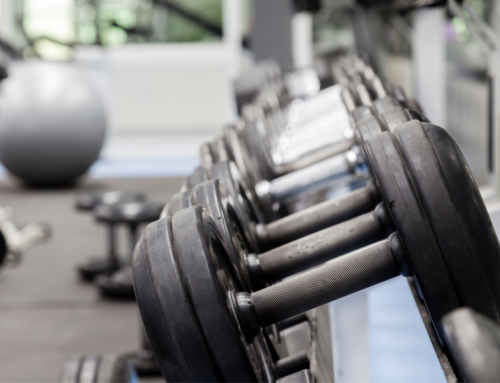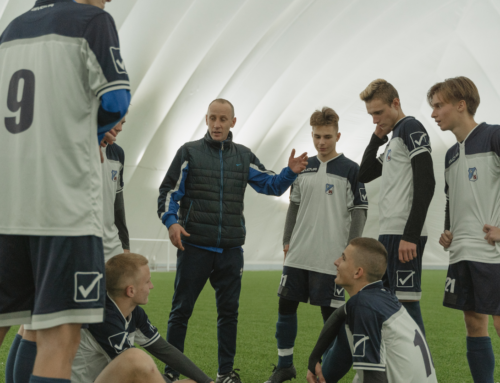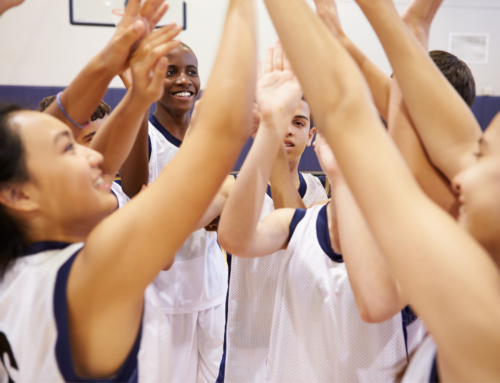If there’s one character trait coaches want to see in every athlete, it’s a tireless work ethic.
Hard-working individuals are coveted regardless of age, gender, or level of play.
The problem?
Almost everyone thinks they work hard.
“Working hard” is a broad term. An overused generalization. One that doesn’t tell us anything concrete, aside from an individual’s interpretation of their own effort.
So, let’s put some real flesh on the bones here.
What specific things distinguish diligent individuals from their less conscientious counterparts?
Here are five things hard-working athletes do to set themselves apart at the high school level.
1. They Show Up Ahead of Time
As the saying goes: “Early is on time, on time is late, and late is unacceptable.”
Nothing irks me more than watching an athlete walk into the weight room a minute or two after the scheduled start time, their shirt untucked and shoelaces untied—painfully oblivious to the fact that, yes, training was supposed to begin at 9 a.m., sharp. Not two minutes past.
I see your skeptical face. “Some kid was late getting in the gym. Big deal. What’s that gotta do with anything?”
Normally, you’d be right. We charge a standard $5 fine for late show-ups, and that’s usually the end of it.
Here’s the thing, though. Ever notice it’s always the same kids who can’t seem to live up to the standards their peers do. No? Well, I have. And it drives me bonkers.
Showing up late, again and again, demonstrates you don’t respect your time, your coach’s time, nor your teammates’ time. It’s a sign of blatant selfishness.
Selfish athletes don’t do well in a team sport setting.
If you mess up once or twice? Not that big of a deal. We all screw up. But eventually, repeated norm violations, no matter how minor they may appear, start to work against you. People simply get tired of your crap after a while.
So, while habitual tardiness may seem like a trivial issue on the surface, it does reveal some major concerning facts about you. Others see you as not being dependable. They think you think you’re above the rules. Once you lose the trust and respect of your teammates and your coaches, it’s really tough to gain it back. Soon, you’re an outcast stuck on the bench—or worse, cut from the roster.
Being “hard-working” involves more than just what goes on the field. You leave it all on the line in every practice and game? Great. But it’s also about how you carry yourself any time you represent your school, club, or country outside of a practice/game situation.
Are you an asset to those around you? Or a negative influence?
If you’re one of those people who seem to be chronically late, no matter the occasion here’s a life-changing tip I’m dishing out for free.
Ready? Adjust your clock 10 minutes forward.
Now, instead of arriving five minutes late, you’re five minutes early. Problem solved.
2. They Are Coachable
While I now work exclusively with D1 college and professional hockey players, I spent my earlier days as a strength coach training mostly high school athletes.
The high school level is where we coaches can have a tremendous impact on young athletes that they’ll carry over their entire career. It’s interesting to see that all my best athletes who went on to play college or pro hockey started training with me at a young age when they were still in high school.
For a coach to truly make a difference, an athlete has to be willing to listen. That’s why I like working with high school/junior hockey players so much. They’re open to new or different ideas, methods and tactics. They actively seek feedback from coaches because they want to get better. And they’re just so easy to get along with.
Pro athletes, on the other hand, are a mixed bunch. Some of them seek your opinion, while others want to do their own thing. Many have their own set beliefs about training and nutrition they cling to. They’re convinced that they’ve got it all figured out already.
Whatever they’re doing must be working because they made it to the pros, right?
Wrong. Some athletes get to the top despite what they do in the weight room, not because of it. But that’s a topic for another day.
My point is this:
As a coach, it’s hard to get through to close-minded athletes. Without even realizing it, they’re handicapping their own progress. The solution is simple. Get out of your own way. Be coachable.
You don’t have to believe everything Coach says as if it were gospel. Thinking for yourself is never a bad thing. But dismissing legit advice because you think you know better is nothing but foolish.
After all, coaches are there to help YOU become a better athlete. If you are not willing to accept feedback or constructive criticism from someone who genuinely has your best interest in mind, then you will never reach your full potential.
3. They Have a Growth Mindset
This one is very much related to the trait of being coachable.
Players who have a growth mindset are never satisfied with what they have achieved so far. They seek constant improvement and keep asking themselves:
“What can I do next to keep getting better?”
One pro athlete who embodies this concept is Sidney Crosby. He spends every offseason working on something he’s lacking.
Back in 2007, Crosby won the Hart Trophy as the NHL MVP. Did he rest on his laurels coming off a monster year? No.
Crosby worked the next couple of summers on his shooting skills—a rare aspect of his game that wasn’t elite.
The result? He won the Rocket Richard Trophy for most NHL goals in 2010.
It’s that everlasting drive and desire to elevate his game that makes Crosby the most decorated hockey player of his generation. And an excellent role model for young athletes to emulate when it comes to developing and cultivating a growth mindset.
4. They Ask Questions and Use What They Learn
As I mentioned earlier, what truly sets the great athletes apart from the good ones is being open-minded and always looking for ways to improve themselves.
One way to get ahead of the competition is by asking questions from those who are more knowledgeable than you. But just receiving advice and then sitting on it won’t do you a lick of good. The key lies in the rapid and precise execution of said advice.
Coach tells you to increase the number of quality fats in your diet and go to bed an hour earlier? Those recommendations mean zilch unless you take the right action.
Implementing what you learn shows you’re serious about getting better. This is what every coach wants to see in a hard-working athlete. Coaches keep track of who acts on the advice they receive and who doesn’t. And whether you realize it or not, what you did or didn’t do weeks or months ago could affect your career going forward—sometimes in ways, you can’t even imagine right now.
To give you an example, a few years back, I was in the gym with our U20 hockey team when a player from the U18 team approached me. He saw our guys doing Weighted Ring Chin-Ups and wanted to know how to get better at the exercise and what I thought good strength numbers to shoot for would be.
I didn’t coach the U18 team at the time, so I had never worked with this athlete, but I knew he was their second team goalkeeper. His name was Filip Lindberg. Just the fact that Filip approached me during a session to ask a training-related question made him stand out from everyone else back then. He certainly seemed to have a good head on his shoulders and the work ethic required for athletic success.
Long story short, I started training Filip less than a year later. We’ve been working together over the past four seasons and his progress has been nothing short of impressive. During that time he won the Best Goaltender Award and First All-Star nomination at the Finnish U18 level, and Second All-Star nomination at the U20 level.
In addition, he won gold with Team Finland at the 2019 IIHF World Junior Championship, backstopped UMass Amherst to the NCAA Final for the first time in school history, and was drafted by the Minnesota Wild in the 2019 NHL Draft.
If you do the math, Filip went from a second-string goalie to play for the U20 National Team and one of the highest-ranked D1 schools in just three years. That probably sounds like an unlikely leap on the surface, but once you peel back the layers, successful traits begin to reveal themselves.
He does everything I tell him without questioning or second-guessing. He doesn’t drink alcohol, skips junk food, and gets his nine to ten hours of sleep every night.
Clearly, that has worked out quite well for him. It was a proud moment for both of us when Filip brought the World Championship trophy for a visit last summer.
From that first encounter in my weight room, I knew this kid could become something special. The signs were there he’d be an open-minded and coachable athlete who would go far in his career. Years later, his stock is on the up-and-up.
I told you us coaches keep track of this stuff, didn’t I?
5. They ‘Get It’
Here’s a story I like to tell my athletes and interns to demonstrate the difference between someone who gets it and someone who doesn’t.
A few years back, our men’s pro hockey club signed a new player just before the offseason started. We had high hopes for him to become the leading D-man on our team.
Around the same time, a new defender joined our U18 team, as well.
Apart from their playing position, there was another thing the pro guy and the junior player had in common. Both were about 20 pounds overweight.
The coaching staff knew our new signings wouldn’t be able to push the pace late in games unless they got rid of the excess body fat.
So, I devised a training and nutrition plan that would strip off the flab over the summer.
Then what happened?
The pro player showed up to training camp looking and weighing exactly the same as he did at the start of the offseason
It’s like none of my advice had registered. I guess he was counting on being able to play his way into shape during the first few months of the season.
The problem is, he never got that far. A few subpar performances to kick off the season, he soon found himself enjoying diminished ice time and, eventually, out of the lineup. Not long after, he drew his own conclusions and left the club.
The last time I heard from this athlete, he was chasing a paycheck away from the spotlight in second-and third-tier leagues in Europe.
As for the 17-year-old junior player, he took my advice to heart and executed on it.
The double chin and love handles were lost. Pounds upon pounds of strength were gained.
Not surprisingly, he became the best defender on the U18 team. To this day, he continues to train with me in the offseason. And based on his improved on-ice performance over the past couple of years, he’s on track to go pro next season.
Moral of the story?
Two players. Similar starting points. Same program.
Yet, two completely different outcomes. How come?
The pro player didn’t “get it.”
The junior player did.
Over the years, the smartest guys I have trained have almost always gotten to be the biggest, fastest and strongest. Not because they were genetically the most gifted or had access to some magical training program. No, it’s because they understood what it means to live, eat, train, and recover like a successful athlete—and they did just that.
At the end of the day, you either “get it” or you don’t.
If you don’t… you’ve already lost.
If you do?
You can go far, kid.
Original article posted on stack.com





